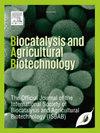Plant growth-promoting Bacillus cereus MCC3402 facilitates rice seedling growth under arsenic-spiked soil
IF 3.4
Q2 BIOTECHNOLOGY & APPLIED MICROBIOLOGY
引用次数: 0
Abstract
Microorganisms can solve the global problem of arsenic (As) contamination in soil and water, by eliminating the hazardous metalloid from contaminated habitats. A native As-resistant PMM6 strain was isolated from the tainted agricultural field in Durgapur, India. Following phenotypic investigations, fatty acid methyl ester analysis, and 16S rDNA sequence-based homology, it was identified as Bacillus cereus. Various analytical techniques such as atomic absorption spectroscopy, Fourier transform infrared spectroscopy, X-ray diffraction, X-ray fluorescence, scanning electron microscopy, transmission electron microscopy and energy dispersive X-ray spectroscopy studies revealed a positive correlation between the strain's resistance properties against arsenate (75 mM) and arsenite (25 mM) and the biosorption and bioaccumulation of arsenic. The strain exhibited several important plant growth-promoting traits, including indole-3-acetic acid production (110.0±0.33μg/mL), 1-aminocyclopropane-1-carboxylate deaminase activity (2334.2±1.90 nm α-ketobutyrate/mg protein/h), phosphate solubilization, and siderophore production (68.0±2%). These traits facilitated the growth augmentation of rice seedlings under As stress, both in terms of physiological and biochemical parameters. Compared to uninoculated soil, the use of strain PMM6 helped to reduce As mobilization and oxidative stress in rice seedlings growing in As-spiked soil. Therefore, strain PMM6 holds the potential as bioremediator to restore As-contaminated agricultural lands while also promoting the growth of rice seedlings. It could thus be utilized in the bioremediation of As-contaminated agricultural lands in the near future.
植物生长促进芽孢杆菌 MCC3402 在含砷土壤中促进水稻幼苗生长
微生物可以解决土壤和水中砷(As)污染这一全球性问题,消除受污染栖息地中的有害类金属。从印度杜尔加布尔受污染的农田中分离出了一株本地抗砷 PMM6 菌株。经过表型调查、脂肪酸甲酯分析和基于 16S rDNA 序列的同源性分析,确定该菌株为蜡样芽孢杆菌。原子吸收光谱、傅立叶变换红外光谱、X 射线衍射、X 射线荧光、扫描电子显微镜、透射电子显微镜和能量色散 X 射线光谱等各种分析技术的研究表明,该菌株对砷酸盐(75 mM)和亚砷酸盐(25 mM)的抗性与砷的生物吸收和生物累积之间存在正相关。该菌株表现出多种重要的植物生长促进性状,包括吲哚-3-乙酸产量(110.0±0.33μg/mL)、1-氨基环丙烷-1-羧酸脱氨酶活性(2334.2±1.90 nm α-酮丁酸/mg蛋白/h)、磷酸盐溶解性和苷元产量(68.0±2%)。这些性状促进了水稻秧苗在 As 胁迫下的生长,包括生理和生化参数。与未接种的土壤相比,使用菌株 PMM6 有助于减少在添加砷的土壤中生长的水稻秧苗的砷迁移和氧化应激。因此,菌株 PMM6 具有生物修复的潜力,既能修复被砷污染的农田,又能促进水稻秧苗的生长。因此,在不久的将来,它可用于砷污染农田的生物修复。
本文章由计算机程序翻译,如有差异,请以英文原文为准。
求助全文
约1分钟内获得全文
求助全文
来源期刊

Biocatalysis and agricultural biotechnology
Agricultural and Biological Sciences-Agronomy and Crop Science
CiteScore
7.70
自引率
2.50%
发文量
308
审稿时长
48 days
期刊介绍:
Biocatalysis and Agricultural Biotechnology is the official journal of the International Society of Biocatalysis and Agricultural Biotechnology (ISBAB). The journal publishes high quality articles especially in the science and technology of biocatalysis, bioprocesses, agricultural biotechnology, biomedical biotechnology, and, if appropriate, from other related areas of biotechnology. The journal will publish peer-reviewed basic and applied research papers, authoritative reviews, and feature articles. The scope of the journal encompasses the research, industrial, and commercial aspects of biotechnology, including the areas of: biocatalysis; bioprocesses; food and agriculture; genetic engineering; molecular biology; healthcare and pharmaceuticals; biofuels; genomics; nanotechnology; environment and biodiversity; and bioremediation.
 求助内容:
求助内容: 应助结果提醒方式:
应助结果提醒方式:


